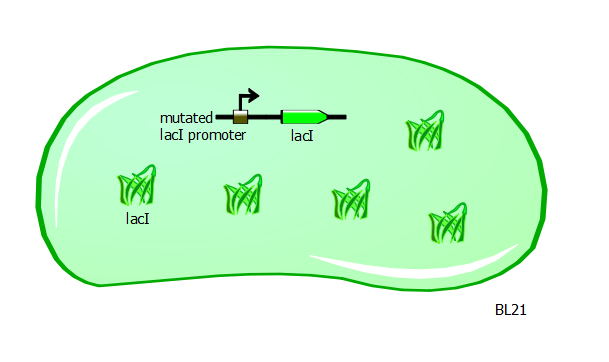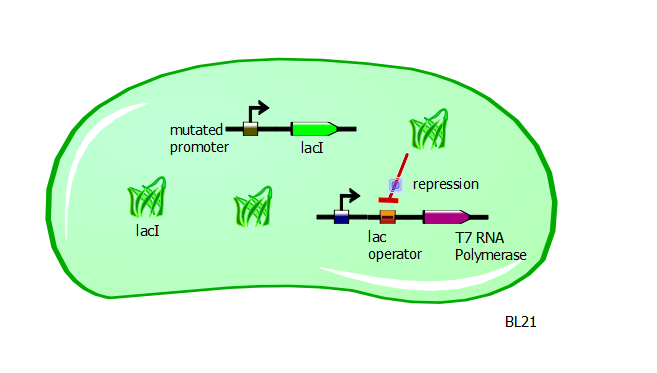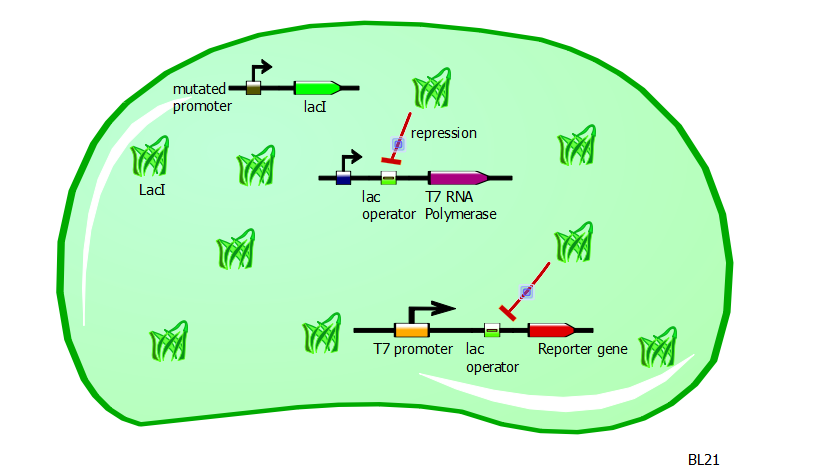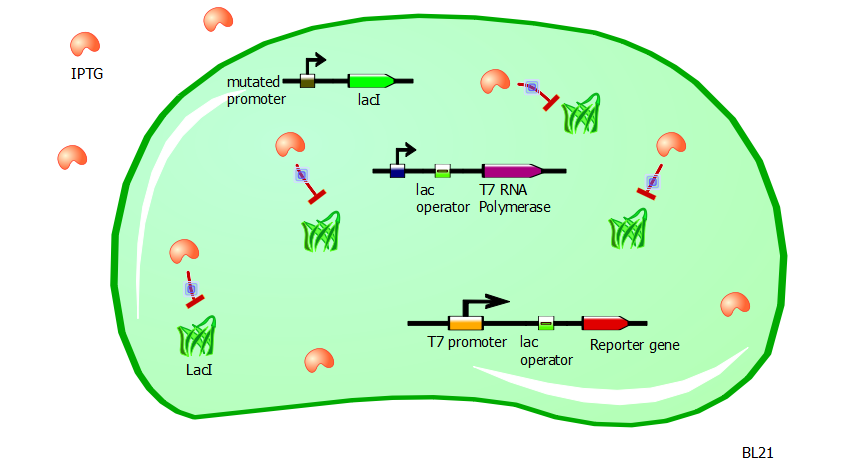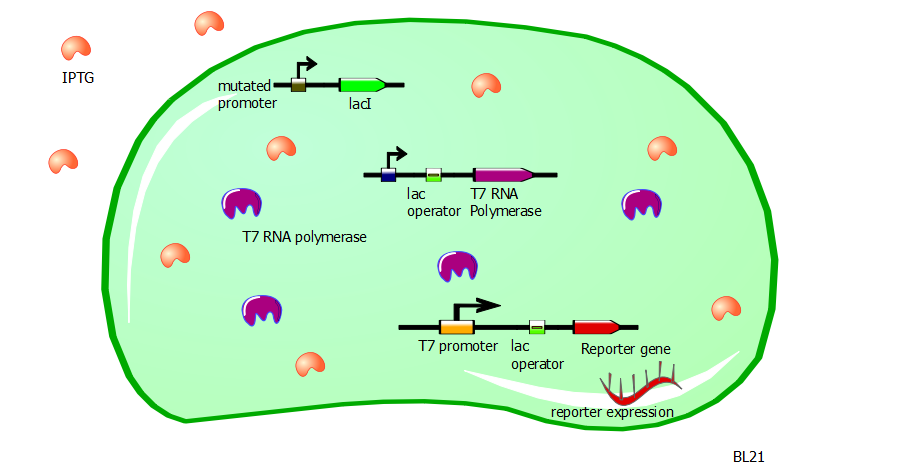EPF-Lausanne/Our Project/T7 promoter variants/lysis/iptg
From 2011.igem.org
(Created page with "{{:Team:EPF-Lausanne/Templates/Header|title=How IPTG Induction Works}} {{:Team:EPF-Lausanne/Templates/Footer}}") |
|||
| (5 intermediate revisions not shown) | |||
| Line 1: | Line 1: | ||
{{:Team:EPF-Lausanne/Templates/Header|title=How IPTG Induction Works}} | {{:Team:EPF-Lausanne/Templates/Header|title=How IPTG Induction Works}} | ||
| + | |||
| + | == Transformation into BL21 == | ||
| + | |||
| + | To use IPTG as a means for testing a reporter expression, we transform the relevant plasmid(s) into BL21 cells. This strain of ''E. coli'' has a mutation in the promoter that is responsible for the transcription of lacI. | ||
| + | |||
| + | [[File:basic_bl21.png|500px|center]] | ||
| + | |||
| + | This mutation causes the overproduction of LacI protein. LacI is a repressor that binds at the lacI operator sequence, wherever it is present, and represses the expression of any downstream gene. In BL21, there is a lacI operator sequence upstream of the gene coding for the T7 RNA polymerase. | ||
| + | |||
| + | [[File:bl21_w_t7rnap_repression.png|500px|center]] | ||
| + | |||
| + | As a result of the overproduction of LacI protein, the lacI operator sequence is bound by LacI protein which blocks the expression and production of the T7 RNA polymerase. Consequently, the BL21 cells in its natural state contains very few T7 RNA polymerases. | ||
| + | |||
| + | [[File:bl21_w_t7lacreporter.png|500px|center]] | ||
| + | |||
| + | In the case of our experiments, we insert a plasmid containing a T7 promoter upstream of a reporter gene (usually RFP or a lysis operon). Without a T7 RNA polymerase, no expression of the reporter will take place since the latter is controlled by the T7 promoter. Even less expression should be expected if the T7 promoter is followed by a lac operator (upstream of the reporter) since the LacI protein will block any attempt by a polymerase to transcribe the reporter. | ||
| + | |||
| + | |||
| + | == Induction with IPTG == | ||
| + | IPTG, short for Isopropyl β-D-1-thiogalactopyranoside, blocks the action of the LacI protein. When IPTG is added to a cell culture, the chemical migrates into the cell where it immediately stops the repression imposed by LacI, thereby allowing the T7 RNA polymerase to be produced. | ||
| + | |||
| + | [[File:bl21_induction_start.png|500px|center]] | ||
| + | |||
| + | The T7 polymerase in turn binds to the T7 promoter and begins the transcription of the reporter gene and induces expression. The LacI protein, being blocked by IPTG, leaves the lac operator sequence alone, so the T7-lac promoters (those equipped with a lac operator) will also promote transcription of the reporter gene. | ||
| + | |||
| + | In sum, the adding of IPTG into a cell culture can, in a very short period of time, activate the expression of a reporter gene that was previously silent. | ||
| + | |||
| + | [[File:bl21_induction_complete.png|500px|center]] | ||
{{:Team:EPF-Lausanne/Templates/Footer}} | {{:Team:EPF-Lausanne/Templates/Footer}} | ||
Latest revision as of 18:49, 21 September 2011
How IPTG Induction Works
Transformation into BL21
To use IPTG as a means for testing a reporter expression, we transform the relevant plasmid(s) into BL21 cells. This strain of E. coli has a mutation in the promoter that is responsible for the transcription of lacI.
This mutation causes the overproduction of LacI protein. LacI is a repressor that binds at the lacI operator sequence, wherever it is present, and represses the expression of any downstream gene. In BL21, there is a lacI operator sequence upstream of the gene coding for the T7 RNA polymerase.
As a result of the overproduction of LacI protein, the lacI operator sequence is bound by LacI protein which blocks the expression and production of the T7 RNA polymerase. Consequently, the BL21 cells in its natural state contains very few T7 RNA polymerases.
In the case of our experiments, we insert a plasmid containing a T7 promoter upstream of a reporter gene (usually RFP or a lysis operon). Without a T7 RNA polymerase, no expression of the reporter will take place since the latter is controlled by the T7 promoter. Even less expression should be expected if the T7 promoter is followed by a lac operator (upstream of the reporter) since the LacI protein will block any attempt by a polymerase to transcribe the reporter.
Induction with IPTG
IPTG, short for Isopropyl β-D-1-thiogalactopyranoside, blocks the action of the LacI protein. When IPTG is added to a cell culture, the chemical migrates into the cell where it immediately stops the repression imposed by LacI, thereby allowing the T7 RNA polymerase to be produced.
The T7 polymerase in turn binds to the T7 promoter and begins the transcription of the reporter gene and induces expression. The LacI protein, being blocked by IPTG, leaves the lac operator sequence alone, so the T7-lac promoters (those equipped with a lac operator) will also promote transcription of the reporter gene.
In sum, the adding of IPTG into a cell culture can, in a very short period of time, activate the expression of a reporter gene that was previously silent.
 "
"
